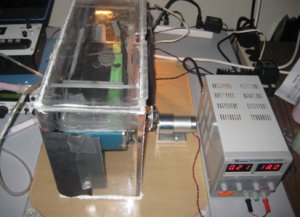Grant: 10-007R
Project Title: Quantifying the energetic cost of disorientation in loggerhead (Caretta caretta) and green (Chelonia mydas) hatchlings
Project Manager: Dr. Sarah Milton
Organization: Florida Atlantic University (Research and Educational Institute)
Grant Amount: $15,957.00
Completion Date: 2011-12-20
Summary: This project will quantify the energetic cost of disorientation upon post-emergent loggerhead and green turtle hatchlings by examining both aerobic and anaerobic metabolism during post-emergent crawling and during the immediate post-crawl frenzy swimming. Hatchlings will move along a treadmill set to a constant speed for both a “short” and “long” disorientation (200 vs. 1000 meters); open-flow respirometry will allow us to assess oxygen consumption and CO2 production (aerobic respiratory component). Blood samples will be drawn prior to and at the end of each trial to measure plasma glucose and lactate to determine anaerobic contributions to metabolism. Following the period of disorientation crawling, hatchlings will be placed in a swim chamber with respirometer to measure swimming performance (oxygen consumption, stroke rate, breathing frequencies and breath lengths). An examination of the energetic cost of disorientation in loggerhead and green hatchlings would assist in determining if a hatchling’s probability of survival decreases as energy is expended upon disorientation. Results: This project was to quantify the energetic cost of disorientation on post-emergent loggerhead and green turtle hatchlings. Emerging hatchlings must cross a variable span of surface sand in order to reach the surf; artificial lighting complicates this task, potentially drawing hatchlings away from their intended destination. Hatchlings face risks associated with this extension of the crawling period: lactate buildup from anaerobic metabolism, depletion of energy stores, and increased risks of dehydration and predation may all decrease the odds of hatchling survival. Despite the availability of glucose stores and the remnants of the yolk sac as an energy supply, the overall energetic cost of disorientation upon hatchlings has not been determined, nor whether a period of disorientation affects swim performance. This study examined measures of energetic in hatchling loggerhead and green turtles crawling for a simulated disorientation of either 200m or 500m, followed by a 30 min swim. The results suggest that there is indeed a risk for hatchlings due to mis- or disorientation events, and that this risk is different for different species. While the overall more active greens are able to crawl continuously even for long distances, this may result in lactate buildup, fatigue, and reduced swim capacity. Loggerhead hatchlings, on the other hand, rest frequently over long distances, which we hypothesize prevents excessive lactate buildup, but this results in greatly extended periods during which the hatchlings would be vulnerable to predation, overheating, and dehydration stress. More data on green hatchling energetics, however, needs to be collected.
Results: This project was to quantify the energetic cost of disorientation on post-emergent loggerhead and green turtle hatchlings. Emerging hatchlings must cross a variable span of surface sand in order to reach the surf; artificial lighting complicates this task, potentially drawing hatchlings away from their intended destination. Hatchlings face risks associated with this extension of the crawling period: lactate buildup from anaerobic metabolism, depletion of energy stores, and increased risks of dehydration and predation may all decrease the odds of hatchling survival. Despite the availability of glucose stores and the remnants of the yolk sac as an energy supply, the overall energetic cost of disorientation upon hatchlings has not been determined, nor whether a period of disorientation affects swim performance. This study examined measures of energetic in hatchling loggerhead and green turtles crawling for a simulated disorientation of either 200m or 500m, followed by a 30 min swim. The results suggest that there is indeed a risk for hatchlings due to mis- or disorientation events, and that this risk is different for different species. While the overall more active greens are able to crawl continuously even for long distances, this may result in lactate buildup, fatigue, and reduced swim capacity. Loggerhead hatchlings, on the other hand, rest frequently over long distances, which we hypothesize prevents excessive lactate buildup, but this results in greatly extended periods during which the hatchlings would be vulnerable to predation, overheating, and dehydration stress. More data on green hatchling energetics, however, needs to be collected.
Read full Final Report (pdf)